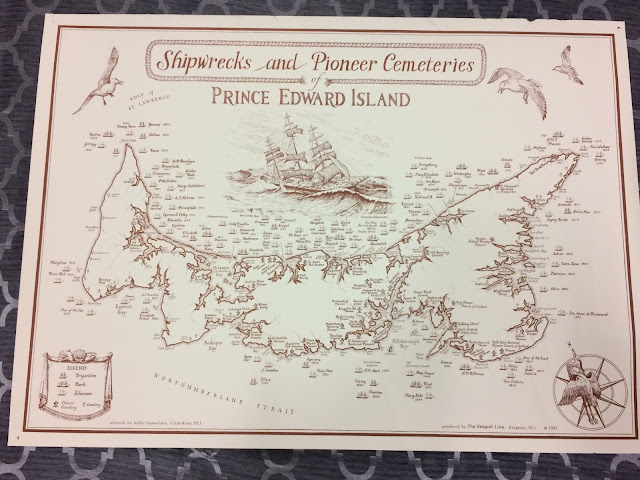Why did Scots Come to PEI?
I was thinking of doing a post on early Scottish immigrants to PEI. I came across "A Very Fine Class of Immigrants": Prince Edward Island's Scottish Pioneers 1770-1850 by Lucille H. Campey. The book's appendixes give copies of ship records from this period, including names, trades, ages, place of residence, parish, and reasons for leaving Scotland.
For this post, I am mainly interested in why they left Scotland. Especially when travelling across the Atlantic was not exactly safe or comfortable.
In 1774 (month not provided), aboard the Lovely Nelly, the people listed one of two reasons for leaving Scotland: "Could not earn bread sufficient to support him and his family" and "could not with all his industry support self and family." The passenger list was made up of labourers, farmers, masons, etc.
In May 1775, some of passengers of the Lovely Nelly have less desperate reasons. While some are still leaving Scotland because they cannot buy bread or support their families in Scotland, others came to get better employment, to make their fortune, help support others who had already come, and some came to heal themselves.
In 1808, the only reason given for the cause of emigration was "want of employ".
Many Highland Scots emigrated to the Belfast area and some gravestones from this period are written in Gaelic.
Most of these people were from the Scottish Highlands. Economic futures in the Highlands was in question. Many were faced with the decision to move to the Lowlands and work in manufacturing or emigrate. Enter Lord Thomas Douglas Selkirk. He had acquired land in Prince Edward Island in the early 1800s and he needed settlers for this land.
 |
| The Highlands and Lowlands. The Highlands had a harsher environment than the Lowlands, which is why many Scottish settlers came from the Highlands (image credit) |
Landlords and lords in Scotland did not want people to leave. They needed a workforce and, if required, people to recruit into the military. Selkirk believed that those faced with moving in the hopes of finding a job but could afford ship fares would opt for emigration. In many cases he was right and some families and communities emigrated together and settled together. Creating communities that attracted more people.
While the Scottish Highlands did not resemble the conditions these settlers faced in PEI, they were used to coping with hardships and isolation and in lands where only certain crops could be grown. While many give Selkirk credit for bringing so many Scots to PEI, it is important to know that he was a late comer. When he brought over about 800 settlers, there was already Scottish communities. Two groups of settlers had already settled in Stanhope and one in Malpeque. Even the records mentioned earlier in this post pre-date him.
Most of Stanhope's settlers were from Perthshire and most of Malpeque's were from Argyll. Some came as indentured servants to Stanhope. James Montgomery was an important Scottish politician and businessman who owned Lot 34. He became interested in establishing a flax farm. He hired David Lawson, a British farmer familiar with growing and harvesting flax, to oversee the farm and in exchange, he would get half the profits after seven years of service. The farm work was performed by 50 indentured servants who agreed to stay for four years. In exchange, after four years, Montgomery promised to rent them land at an inexpensive rate.
The conditions once they landed were not what they were expecting but a shipment of food did eventually arrive from Three Rivers. The next four years were hard. The mill was destroyed twice, once by fire and once in a flood, a worker was crushed by a large pine tree he was chopping down, and two men drowned. Then, right when the farm began to make money, the indentured servant contracts expired and the workers moved to various parts of the Island.
After the Battle of Culloden, English began suppressing Scottish culture and attempted to force them to renounce their Roman Catholic faith. Bishops approached Captain MacDonald, the 8th laird of Glenaladale. He sent his brother to find a suitable place to settle and after hearing exaggerated rumours about the success of Montgomery's flax farm and the mild climate, they bought Lot 36 from Montgomery.
Protestant landlords in Scotland were worried about losing their tenants and spread rumours that those who went to the Island would be sold into slavery. As a result, only 210 initially followed MacDonald to the Island.
The conditions on the Island were not what they were expecting after hearing the rumours about fertile soil and mild climate. One Catholic priest wrote " There is no money, no clothes, and no meat unless we pay four times what it is worth. It breaks my heart that my poor friends who were doing well before they left Scotland are now upon the brink of great misery and poverty."
Obviously, things did change for the settlers but, many came over based on exaggerated stories of available fertile soil and a mild climate. But did they have a better life here than if they had stayed in Scotland?
That is impossible to answer. It appears many were realistic in their expectations. They were not expecting to have an easy life in the colonies, just better than they would have had if they remained in Scotland. So the question of did they have a better life here than if they had remained in Scotland really depends on the person, their expectations, what they gave up in Scotland, and what they gained by going to PEI.
Baldwin, Douglas. Prince Edward Island: An Illustrated History. Toronto: Nimbus Publishing Limited, 2009.
Campey, Lucille H. "A Very Fine Class of Immigrants:" Prince Edward Island's Scottish Pioneers 1770-1850. Toronto: Natural Heritage Books, 2007.


Comments
Post a Comment